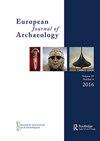Reconstructing the Biography of Children's Stone Bracers in the Iberian Peninsula
IF 1.4
2区 历史学
0 ARCHAEOLOGY
引用次数: 1
Abstract
Perforated stone plaques, known as bracers, are found across late prehistoric Europe and many of them have been recovered in Bell Beaker funerary contexts, usually associated with adult individuals. Experimental, technological, and use-wear studies have determined that the bracers were both utilitarian and symbolic objects. Very few are found in children's graves, but examples are known in the Iberian Peninsula, two of which are presented here. The analyses conducted on the two bracers, including archaeological contextualization, raw material identification, and technological and use-wear studies, allow the authors to reconstruct their respective biographies. Although these pieces were associated with young children, they had long lives before their final deposition in the graves. Use-wear marks on one of the bracers suggest that it was used in archery, despite its small size.重建伊比利亚半岛儿童石手镯传
穿孔的石头牌匾,被称为支架,在史前晚期的欧洲被发现,其中许多在贝尔烧杯葬礼中被发现,通常与成年人有关。实验、技术和使用研究表明,这种护腕既实用又无害。在儿童坟墓中发现的很少,但在伊比利亚半岛已知的例子,这里介绍了其中两个。对这两个手镯进行的分析,包括考古背景化、原材料鉴定、技术和使用磨损研究,使作者能够重建他们各自的传记。虽然这些碎片与年幼的孩子有关,但它们在最终被埋在坟墓里之前已经有很长的寿命了。其中一个手镯上的磨损痕迹表明,尽管它很小,但它曾用于射箭。
本文章由计算机程序翻译,如有差异,请以英文原文为准。
求助全文
约1分钟内获得全文
求助全文
来源期刊

European Journal of Archaeology
ARCHAEOLOGY-
CiteScore
3.40
自引率
6.70%
发文量
58
期刊介绍:
The publication organ of the European Association of Archaeologists, the European Journal of Archaeology seeks to promote open debate amongst archaeologists committed to a new idea of Europe in which there is more communication across national frontiers and more interest in interpretation. The journal accepts not only new empirical data and new interpretations of the past but also encourages debate about the role archaeology plays in society, how it should be organized in a changing Europe, and the ethics of archaeological practice. All periods are covered; papers, review articles, interviews and short "debate" pieces are all sought. Whilst English is the primary language of publication in the EJA, papers submitted in French or German will be given equal consideration.
 求助内容:
求助内容: 应助结果提醒方式:
应助结果提醒方式:


